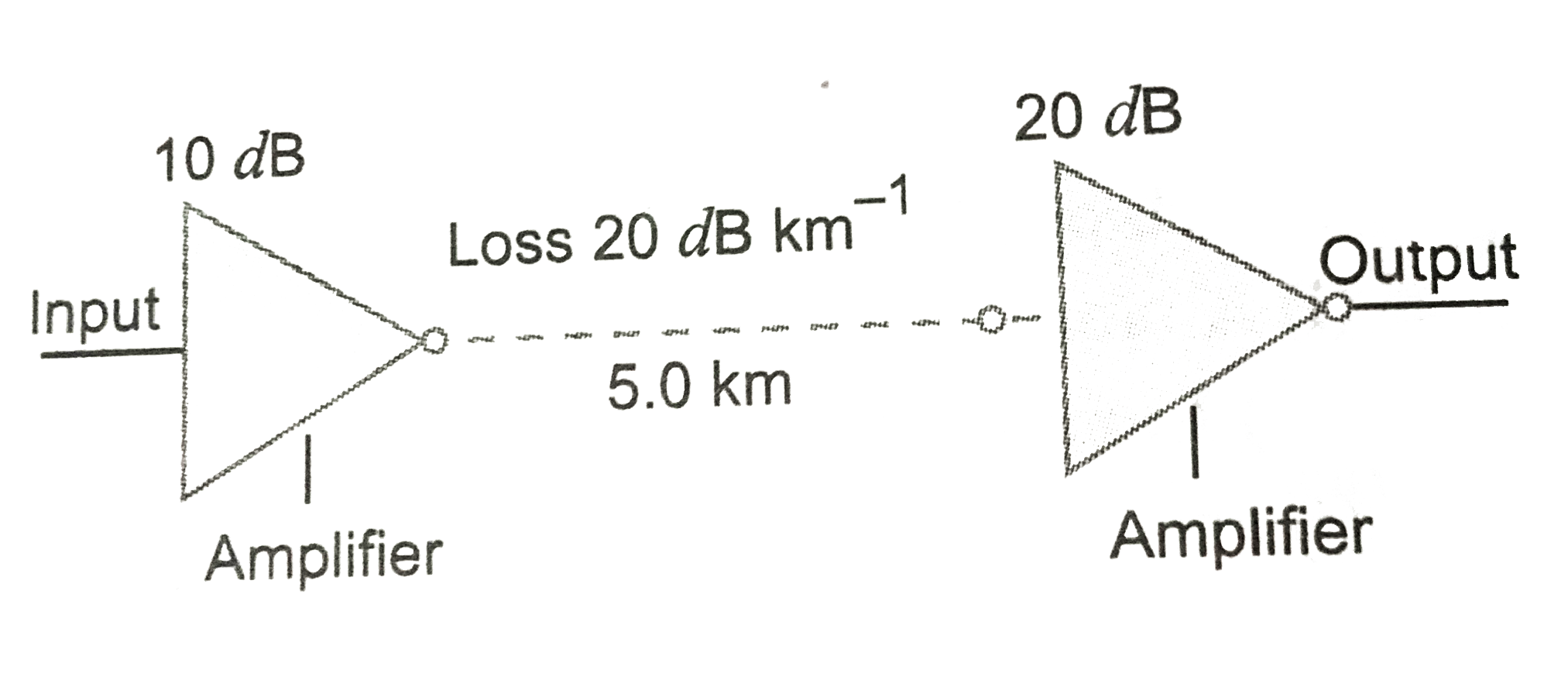A 1kW signal is transmitted using a communication channel which provides attrenuation at the rate of -2 d B per km. if the communication channel has a total length of 5 km, the power of the signal received is gain in dB=10log(P0Pi)
900W
100W
990W
1010W
The correct Answer is:B
Loss suffered in the communication channel
=(−2dB/km)5km=−10dB
∴10log(P0/Pi)=−10,or log(P0/Pi)=−1
or (P0/Pi)=10−1=110
or P0=Pi/10=1kW10=100W
Topper's Solved these Questions
- COMMUNITCATION SYSTEMSBOOK - NCERT FINGERTPS ENGLISHCHAPTER - COMMUNITCATION SYSTEMSEXERCISE - CORNER
15 Videos
- COMMUNITCATION SYSTEMSBOOK - NCERT FINGERTPS ENGLISHCHAPTER - COMMUNITCATION SYSTEMSEXERCISE - Introduction
2 Videos
- COMMUNITCATION SYSTEMSBOOK - NCERT FINGERTPS ENGLISHCHAPTER - COMMUNITCATION SYSTEMSEXERCISE - HOTS
20 Videos
- ATOMS BOOK - NCERT FINGERTPS ENGLISHCHAPTER - ATOMS EXERCISE - Assertion And Reason
15 Videos
- CURRENT ELECTRICITYBOOK - NCERT FINGERTPS ENGLISHCHAPTER - CURRENT ELECTRICITYEXERCISE - Assertion And Reason
15 Videos
Similar Questions
A 1KW signal is transmitted using a communication channel which provides attenuatiom at the rate of −2dBperkm . If the communication channel has a total length of 5km , the power of the signal received is
[ gain in dB=10log(P0Pi)]
View SolutionFigure (EP) shows a communication system. What is the output power when input signals is of 1.01 mW? [ gain in dB=10log10(P0/Pt)].

View Solution
Knowledge Check
A 1kW signal is transmitted using a communication channel which provides attrenuation at the rate of -2 d B per km. if the communication channel has a total length of 5 km, the power of the signal received is gain in dB=10log(P0Pi)
A900WB100WC990WD1010WA 1KW signal is transmitted using a communication channel which provides attenuatiom at the rate of −2dBperkm . If the communication channel has a total length of 5km , the power of the signal received is
[ gain in dB=10log(P0Pi)]A900WB100WC990WD1010WFigure (EP) shows a communication system. What is the output power when input signals is of 1.01 mW? [ gain in dB=10log10(P0/Pt)].
 A90mWB101mWC1112mWD120mW
A90mWB101mWC1112mWD120mW
Perhaps, the most commonly used mode of communication involves use of free space as a communication channel between transmitter and receiver. The various possible modes of using of free space have been described below
Ground wave communication : This mode is used for low frequency as at high frequency, losses become large. This is useful for distance of the order of 1 km.
Space wave communication: The signals are transmitted directly from transmitter to receiver. There is no limit to upper frequency, but its range is limited to few hundred kilometers. The range depends on the height of transmitting antenna
Sky wave communication : The signals are sent towards sky They are reflected back towards earth by ionosphere. Its range can be above 500 km. But, very high frequencies (above 10 MHz) are not reflected back. Satellite communication: The signals that cannot be reflected back by ionosphere are reflected back by satellite. Moon is a passive satellite of earth.
The frequency range allotted to FM radio broadcast is 88 MHz to 108 MHz. Which of the following communication channels can be used for its transmission?
A. Sky wave communication only
B. Space wave communication only
C. Satellite communication only
D. Either space wave communication or satellite communication
View SolutionThe reaction 2AX(g)+2B2(g)→A2(g)+2B2X(g) has been studied kinetically and on the baiss of the rate law following mechanism has been proposed.
I. 2AX⇔A2X2 (fast and reverse)
II. A2X2+B2→A2X+B2X
III. A2X+B2→A2+B2X
where all the reaction intermediates are gases under ordinary condition.
form the above mechanism in which the steps (elementary) differ conisderably in their rates, the rate law is derived uisng the principle that the slowest step is the rate-determining step (RDS) and the rate of any step varies as the Product of the molar concentrations of each reacting speacting species raised to the power equal to their respective stoichiometric coefficients (law of mass action). If a reacting species is solid or pure liquid, its active mass, i.e., molar concentration is taken to be unity, the standard state. In qrder to find out the final rate law of the reaction, the concentration of any intermediate appearing in the rate law of the RDS is substituted in terms of the concentration of the reactant(s) by means of the law of mass action applied on equilibrium step.
Let the equilibrium constant of Step I be 2×10−3mol−1L and the rate constants for the formation of A2X and A2 in Step II and III are 3.0×10−2mol−1L−1min and 1×103mol−1L−1min (all data at 25∘C), then what is the overall rate constant (mol−2L2−1min) of the consumption of B2?
View SolutionA uniform magnetic field B exists in a direction perpendicular to the plane of a square frame made of copper wire. The wire has a diameter of 2 mm and a total length of 40cm. The magntic field changes with time at a steady rate dBdt=0.02Ts−1. Find the current induced in the frame. Resistivity of copper =1.7X10−8Wm.
View SolutionFigure shows a communication system. What is the output power when input is 1.01 mW? (Gain in dB=10log10PoPi)

View Solution(i) The intensity of a light pulse travelling along a communication channel decreases exponentially with distance x according to the relation I=I0e−αx, where I0 is the intensity at x=0 and α is the attenuation constant.
Show that the intensity reduces by 75 percent after a distance of ln4α
(ii) Attenuation of a signal can be expressed in decibel (dB) according to the relation
dB =10log10(I/I0). What is the attenuation in dB/km for an optical fibre in which the intensity falls by 50 percent over a distance of 50 km?
View Solution
